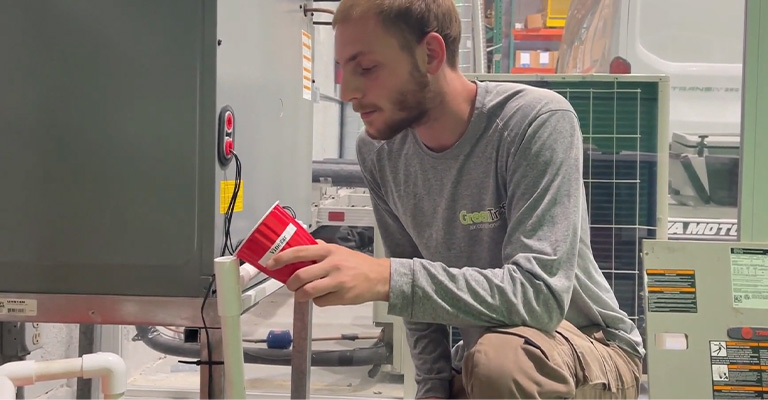Cleaning your air conditioning (AC) drain line with vinegar is a simple yet effective way to maintain the efficiency and functionality of your AC unit.
Over time, dust, debris, and algae can accumulate in the drain line, leading to clogs and potential water damage. Fortunately, using vinegar as a cleaning agent can help dissolve these blockages and prevent costly repairs.
In this guide, we’ll walk you through the steps to clean your AC drain line with vinegar, ensuring that your system operates smoothly and keeps your indoor space cool and comfortable.
How Much Vinegar Do I Need To Clean AC Drain Line?
To clean an AC drain line, you will need approximately 1 cup of vinegar. Pour the vinegar into the drain line and let it sit for 30 minutes.
After 30 minutes, flush the vinegar with cold water. Through the opening where the cap is removed, add 1/4 cup of distilled vinegar to the drain line.
White vinegar’s cleaning properties are enhanced by its increased acidity, so it’s recommended to use regular distilled white vinegar.
You can also use peroxide or hot water and dish soap if you dislike the smell of vinegar.
Refreshing Your AC: A Simple Guide to Cleaning the Condensate Drain with Vinegar
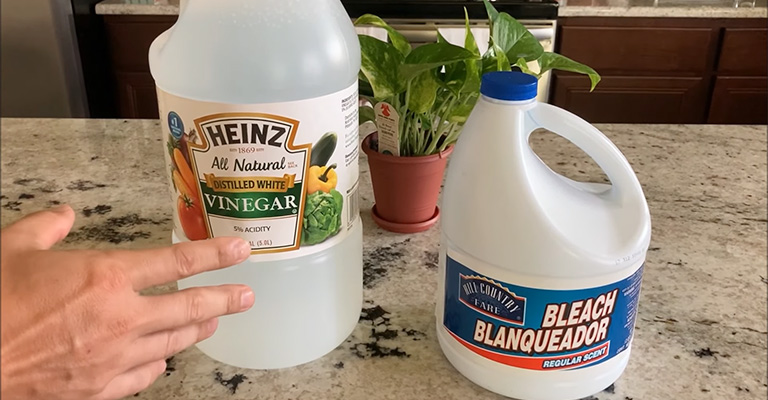
Most homeowners need professional AC repair services because their condensate drain line is clogged.
It is important to remember that most homeowners do not realize the problem is usually avoidable with regular maintenance and DIY air conditioner fixes.
It is likely that you will be able to remove the clog yourself if your condensate drain line is clogged. Here is an easy guide to help you get started.
Cleaning your AC drain regularly can prevent clogs. You can kill mold, algae, mildew, and other bacteria or fungi in your AC drain line by pouring 1/4 cup of vinegar into it.
Keeping it from building up and clogging. For the best results, repeat this process monthly. Check out this step-by-step guide on how to keep your drain line running efficiently with vinegar.
Step 1:
You should turn off your air conditioner. Both the thermostat and the breaker should be turned off.
Step 2:
Find the condensate drain line. A PVC pipe attaches to the wall of your home near your outdoor unit and drains water away from it.
Step 3:
Determine where the drain line has an access point. There will usually be a T-shaped vent tee with a cap or cover on drain lines. Inspect the drain for blockages after removing the cap.
Step 4:
Use distilled vinegar to flush it. The drain line should be filled with ¼ cup of distilled vinegar after the cap has been removed.
Because regular distilled white vinegar has an increased acidity level, its cleaning properties are enhanced. Peroxide or hot water and dish soap can also be used if you find vinegar offensive.
Step 5:
Allow the solution to sit for 30 minutes. Make sure everything flows freely and works properly by flushing out the pipe with water.
Step 6:
Repeat every month. Your drain line should be cleaned every 30 days to eliminate any harmful bacteria or buildup and ensure your system continues to operate at its best.
What Does My AC Condensate Drain Line Do?
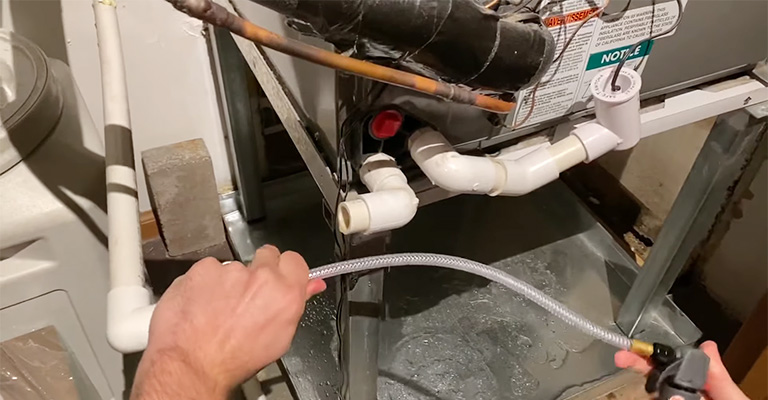
You can ensure that your AC unit operates efficiently by using the condensate drain line connected to your AC unit.
You need your condensate line to drain the condensation from the evaporator coil to the outside of your house so that it can be drained.
Why The AC’s Drain Line Needs To Be Clear
PVC pipes are used to drain condensation from your air conditioner’s drain line. Basically, it drains the water from your home and your HVAC system from the evaporator coil.
A dirty drain line can harbor germs and algae that could lead to a blocked drain if not properly maintained. Consequently, your drain pan may overflow, causing water damage to your home.
The last thing anyone wants to do is waste their time or energy cleaning up after their drain line or any other larger problem. Therefore, regular pipeline maintenance is essential for preventing clogs and keeping your pipeline clean.
Clogged AC Drain Line Symptoms and Causes
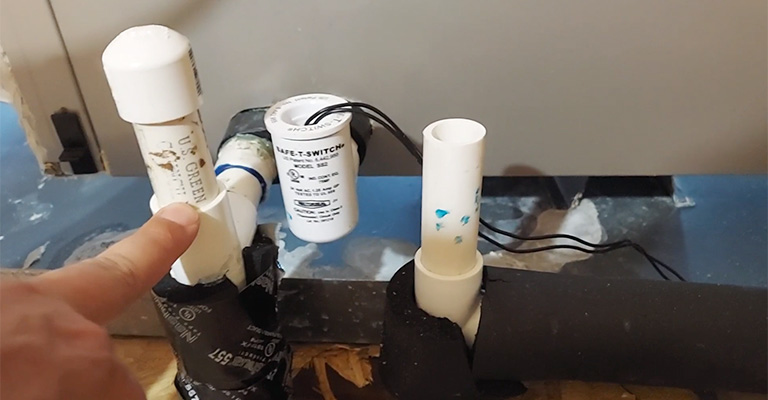
AC drain lines that are blocked will show some signs that need to be cleaned. The following signs may indicate you need to clean your drain line with vinegar:
- You smell mold coming from your drain or from the vents of your cooling system
- Damage to your unit caused by water
- You are no longer able to keep your house cool with your air conditioner
- There are times when your air conditioner suddenly shuts off
- You may have standing water near the condenser of your AC
Condensation collects in the drain line of your air conditioner, providing the perfect breeding ground for mold and algae. In the condensate drain line, sludge and buildup accumulate over time.
Mold and mildew can be present along with algae, bacteria, fungi, and even small plants. In the event that too much buildup accumulates, the blockage in the line can become too large, causing water to back up into the drain pan of the AC.
Overflowing condensate drain pans can cause excessive water to leak into your home, causing water damage issues that can become expensive to repair.
Your central air conditioning system can be compromised by improper or neglected drain line cleaning, resulting in elevated humidity, musty odors, and potentially serious problems.
You should check your drain for blockage if you notice any of these signs. If you are successful in clearing your drain line with vinegar, you should be able to stop experiencing the problems you’ve been experiencing.
Your local HVAC repair service professionals will be able to check your system if flushing the drain proves ineffective.
How to Prevent AC Drain Line Clogs?
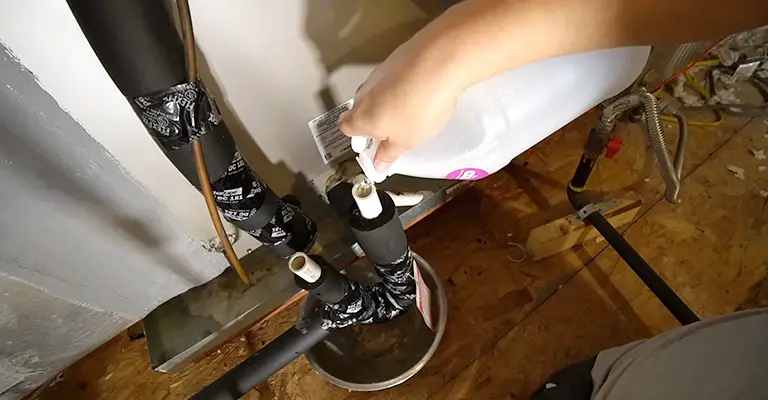
If you now understand what clogs and blockages occur in AC drain lines, you might wonder how to avoid them in the future.
At the beginning of each spring, pour a cup of bleach down your drain line to prevent clogs. By doing so, algae and mold will be eliminated before they become an issue.
You can also prevent troublesome blockages by investing in high-quality HVAC filters. Filters designed for high-end systems trap debris and unwanted particles to prevent clogging. Changing your filters every three months is also a good idea.
A Clean AC is a Healthy AC
There are a few things you can do to help keep your AC and HVAC working well between professional, expert maintenance visits. You’ll be surprised at how easy it is.
Routine maintenance, as well as pro maintenance, is also much more cost-effective and less of a headache. It is easy to clean drain lines with vinegar, for example.
Having your AC professionally maintained on a regular basis will keep it performing at its best all year round.
Final Words
If your AC is giving you trouble, you might be able to fix it without hiring an HVAC technician. It is important to check whether the condensate drain line of your AC is blocked before calling the technicians.
There are a few simple steps you can follow if your AC drain line is clogged with a lot of debris. Vinegar can be used to clean AC drain lines, saving you money and giving you the satisfaction of a job well done.

